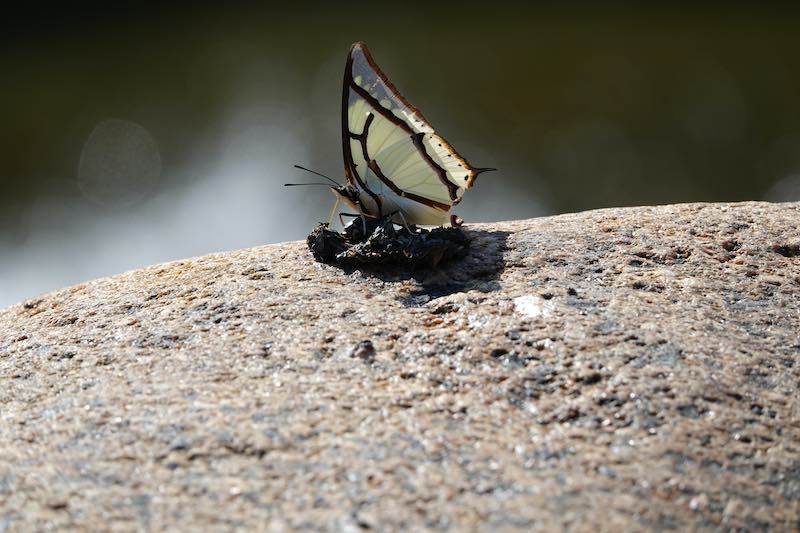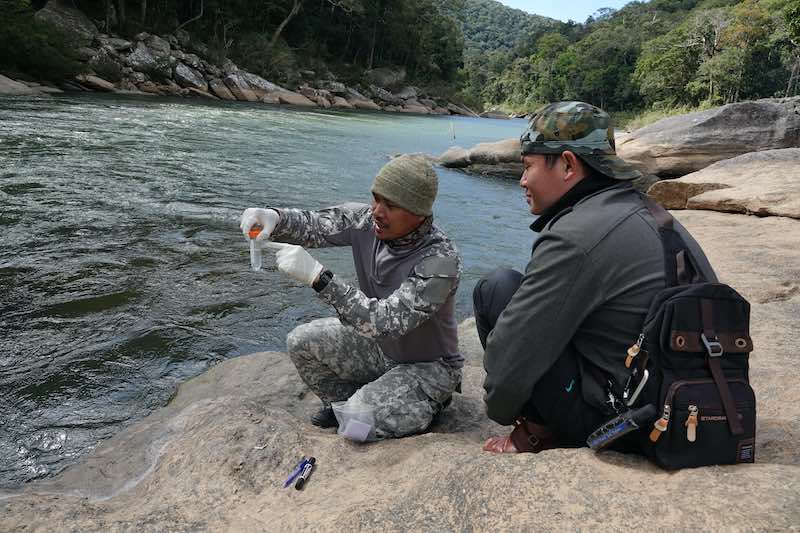
We’re in the Annamite Mountains of Laos with Camille Coudrat and the team at Association Anoulak.
If you missed the first part of our adventure, click to read about our exciting journey into the Nakai-Nam Theun National Park.
Today, we’re at camp learning about river otters, like these ones:

I, ArtMechanic, CC BY-SA 3.0 http://creativecommons.org/licenses/by-sa/3.0/, via Wikimedia Commons

SeanMack, CC BY-SA 3.0 http://creativecommons.org/licenses/by-sa/3.0/, via Wikimedia Commons
Not much is known about the otters of Nakai-Nam Theun National Park …
Camille tells us that two species of river otter have been sighted in the area. One is the Asian small-clawed otter seen in the photos above. The other is a larger unidentified species. But there could be as many as three types of otters in the park.
Camille and the team have been doing some otter surveys to learn more. Here are some of the things they want to find out:
- How many otter species live in the national park? How closely related are the different otter populations?
- How many individual otters live in the park? Are there equal numbers of female and male otters?
- Where do otters live in the park? Do different species share the same area or live in separate areas?
Gathering this information will help scientists plan more research studies on otter ecology, or how they interact with other animals and their environment. It will help them plan studies on otter behavior, or what they do. It will also make it easier to protect the otters of the Nakai-Nam Theun National Park.
We’re super excited to join the team on their next survey!
Before we go, let’s learn a few things about otters:
There are 13 types of otters. Otters can be found on all continents except Australia and Antarctica.
The otters in Laos are river otters. River otters live near rivers, streams, and other waterways, but they also spend time on land and have dens where they keep their young.
River otters use waterways to travel and hunt. River otters are carnivores. Fish, crabs, and other aquatic organisms are important in their diet. They sometimes eat other protein-rich foods like eggs or frogs.
Otter poop is also called spraint. Spraint contains bits of shell or bone that remain after the otter has digested its food. Spraint has a strong smell. Otters use spraint to communicate and mark their territories.
Finding spraint is a very useful thing when you are tracking otters. Another sign we can use to find otters is tracks, or prints.
Some types of otters are social and live in large groups. Some types are more territorial and live alone or in small family groups. Otters are playful. Play helps otters bond and helps them learn behavior like hunting.
We’re gearing up for the survey: Time to track otters!
We’ll be checking for otters along the rivers and streams of the Nakai-Nam Theun National Park. Check out this map of the park, outlined in black. The blue lines are rivers and streams. The red lines are the places where we plan to look for signs of otters:

Now that we’ve learned some otter basics, and our gear is loaded, we’re ready to go on our adventure! Camille and the team have done these otter surveys before, so they are experienced and know just what to do.
We’re using canoes and rafts to travel by water.


We travel along rivers and waterways, checking for signs of otters. At times, we move by land, checking for spraints and prints. Trekking is hard work, but it is also fun. We explore gorgeous rivers and streams. We even see cascading waterfalls.


We spot otter prints! We must be on the right track …


Next we find some otter spraint. This is so exciting!

This spraint has a butterfly on it! What do you think the butterfly is doing?

We need to collect samples …
It is good that we’ve found spraint because we need to collect fecal samples, or small amounts of poop. The poop samples will be sent to a lab for DNA analysis. The researchers will use the DNA to answer some of their questions, such as how many types of otters there are and how many males vs. females.
Basically, we collect a small specimen of the spraint, place it in a tube, and add a liquid that contains a preservative. The preservative keeps the DNA from breaking down before it gets to the lab, which is a long way from here! We wear gloves so that we don’t contaminate the samples. We also record information about each sample, such as where we found it and if the poop was fresh or dry.


As we continue on our survey, we hear a whisper from one of our guides. He has spotted otters in the distance! This is so exciting. We keep a safe distance so that we disturb the otters as little as possible.
Check out these otters at play! It’s amazing:
What a busy day. Time to set up camp and rest. This has been another awesome …

Watch this video to experience otter surveys in Nakai-Nam Theun National Park!
See the whole experience: canoeing and trekking, following the clues, collecting poop samples, and setting up camp after a long day.
What did you learn?
- Name two reasons why it is important to survey otters in Nakai-Nam Theun National Park.
- Describe what a day surveying otters is like. What part of the survey experience would be most exciting to you? Can you imagine any challenges you might face?
- What are two helpful signs or clues that we can use to track otters?
- What is another name for otter poop?
- Why is the research team collecting otter fecal samples (poop)?
For educators:
Read more about Association Anoulak and their otter surveys in Laos:
https://www.conservationlaos.com/in-search-of-otter-poo-in-nakai-nam-theun-national-park/
https://www.conservationlaos.com/update-from-our-otter-surveys-in-nakai-nam-theun-national-park/
Extension: Older students may want to read the fecal sampling protocol – a guideline to how to properly collect and store poop samples in the field.






